transmission GMC SIERRA 2007 Owner's Manual
[x] Cancel search | Manufacturer: GMC, Model Year: 2007, Model line: SIERRA, Model: GMC SIERRA 2007Pages: 680, PDF Size: 3.42 MB
Page 107 of 680
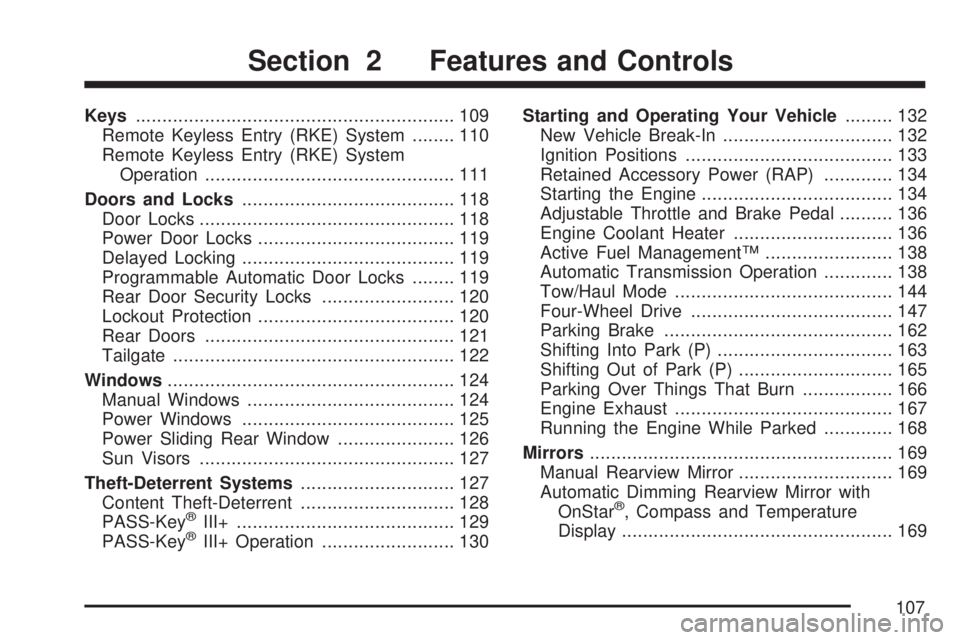
Keys............................................................ 109
Remote Keyless Entry (RKE) System........ 110
Remote Keyless Entry (RKE) System
Operation............................................... 111
Doors and Locks........................................ 118
Door Locks................................................ 118
Power Door Locks..................................... 119
Delayed Locking........................................ 119
Programmable Automatic Door Locks........ 119
Rear Door Security Locks......................... 120
Lockout Protection..................................... 120
Rear Doors............................................... 121
Tailgate..................................................... 122
Windows...................................................... 124
Manual Windows....................................... 124
Power Windows........................................ 125
Power Sliding Rear Window...................... 126
Sun Visors................................................ 127
Theft-Deterrent Systems............................. 127
Content Theft-Deterrent............................. 128
PASS-Key
®III+......................................... 129
PASS-Key®III+ Operation......................... 130Starting and Operating Your Vehicle......... 132
New Vehicle Break-In................................ 132
Ignition Positions....................................... 133
Retained Accessory Power (RAP)............. 134
Starting the Engine.................................... 134
Adjustable Throttle and Brake Pedal.......... 136
Engine Coolant Heater.............................. 136
Active Fuel Management™........................ 138
Automatic Transmission Operation............. 138
Tow/Haul Mode......................................... 144
Four-Wheel Drive...................................... 147
Parking Brake........................................... 162
Shifting Into Park (P)................................. 163
Shifting Out of Park (P)............................. 165
Parking Over Things That Burn................. 166
Engine Exhaust......................................... 167
Running the Engine While Parked............. 168
Mirrors......................................................... 169
Manual Rearview Mirror............................. 169
Automatic Dimming Rearview Mirror with
OnStar
®, Compass and Temperature
Display................................................... 169
Section 2 Features and Controls
107
Page 133 of 680
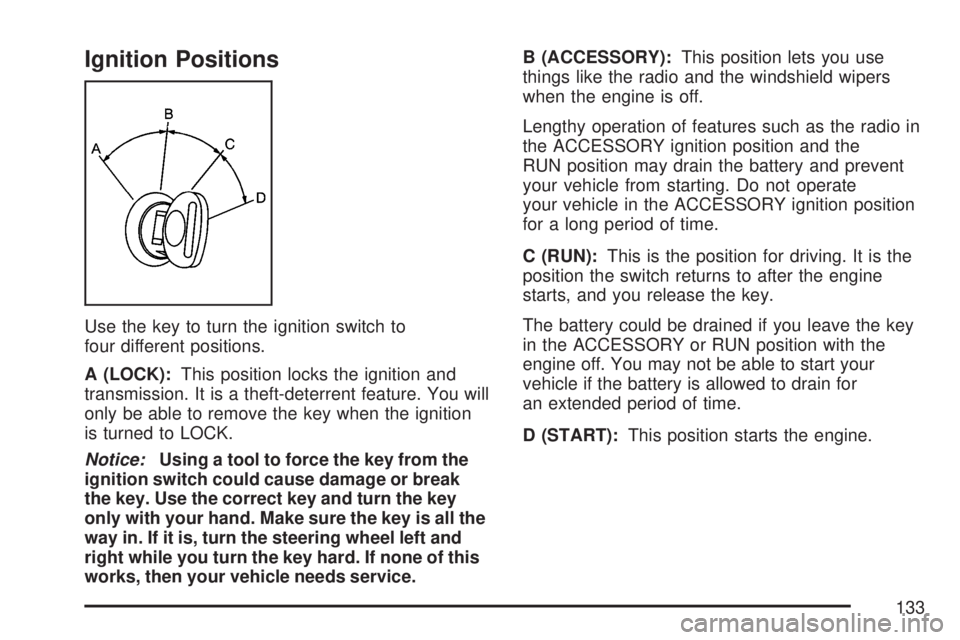
Ignition Positions
Use the key to turn the ignition switch to
four different positions.
A (LOCK):This position locks the ignition and
transmission. It is a theft-deterrent feature. You will
only be able to remove the key when the ignition
is turned to LOCK.
Notice:Using a tool to force the key from the
ignition switch could cause damage or break
the key. Use the correct key and turn the key
only with your hand. Make sure the key is all the
way in. If it is, turn the steering wheel left and
right while you turn the key hard. If none of this
works, then your vehicle needs service.B (ACCESSORY):This position lets you use
things like the radio and the windshield wipers
when the engine is off.
Lengthy operation of features such as the radio in
the ACCESSORY ignition position and the
RUN position may drain the battery and prevent
your vehicle from starting. Do not operate
your vehicle in the ACCESSORY ignition position
for a long period of time.
C (RUN):This is the position for driving. It is the
position the switch returns to after the engine
starts, and you release the key.
The battery could be drained if you leave the key
in the ACCESSORY or RUN position with the
engine off. You may not be able to start your
vehicle if the battery is allowed to drain for
an extended period of time.
D (START):This position starts the engine.
133
Page 134 of 680
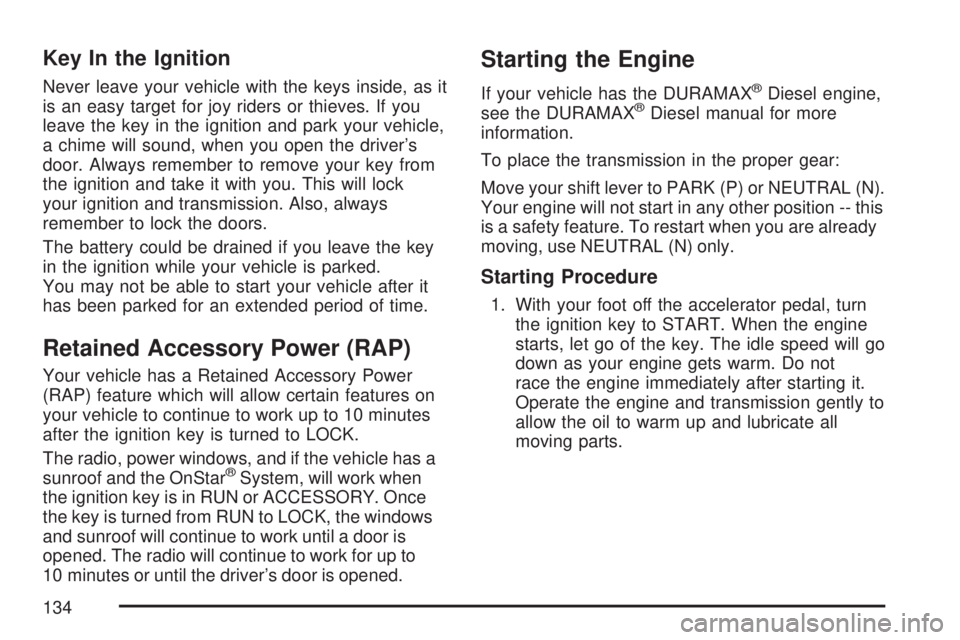
Key In the Ignition
Never leave your vehicle with the keys inside, as it
is an easy target for joy riders or thieves. If you
leave the key in the ignition and park your vehicle,
a chime will sound, when you open the driver’s
door. Always remember to remove your key from
the ignition and take it with you. This will lock
your ignition and transmission. Also, always
remember to lock the doors.
The battery could be drained if you leave the key
in the ignition while your vehicle is parked.
You may not be able to start your vehicle after it
has been parked for an extended period of time.
Retained Accessory Power (RAP)
Your vehicle has a Retained Accessory Power
(RAP) feature which will allow certain features on
your vehicle to continue to work up to 10 minutes
after the ignition key is turned to LOCK.
The radio, power windows, and if the vehicle has a
sunroof and the OnStar
®System, will work when
the ignition key is in RUN or ACCESSORY. Once
the key is turned from RUN to LOCK, the windows
and sunroof will continue to work until a door is
opened. The radio will continue to work for up to
10 minutes or until the driver’s door is opened.
Starting the Engine
If your vehicle has the DURAMAX®Diesel engine,
see the DURAMAX®Diesel manual for more
information.
To place the transmission in the proper gear:
Move your shift lever to PARK (P) or NEUTRAL (N).
Your engine will not start in any other position -- this
is a safety feature. To restart when you are already
moving, use NEUTRAL (N) only.
Starting Procedure
1. With your foot off the accelerator pedal, turn
the ignition key to START. When the engine
starts, let go of the key. The idle speed will go
down as your engine gets warm. Do not
race the engine immediately after starting it.
Operate the engine and transmission gently to
allow the oil to warm up and lubricate all
moving parts.
134
Page 135 of 680

Your vehicle has a Computer-Controlled
Cranking System. This feature assists
in starting the engine and protects
components. If the ignition key is turned to the
START position, and then released when
the engine begins cranking, the engine
will continue cranking for a few seconds or
until the vehicle starts. If the engine does not
start and the key is held in START for
many seconds, cranking will be stopped after
15 seconds to prevent cranking motor
damage. To prevent gear damage, this system
also prevents cranking if the engine is
already running. Engine cranking can be
stopped by turning the ignition switch to the
ACCESSORY or LOCK position.
Notice:Cranking the engine for long periods
of time, by returning the key to the START
position immediately after cranking has ended,
can overheat and damage the cranking
motor, and drain the battery. Wait at least
15 seconds between each try, to allow
the cranking motor to cool down.2. If the engine does not start after 5-10 seconds,
especially in very cold weather (below 0°F or
−18°C), it could be �ooded with too much
gasoline. Try pushing the accelerator pedal all
the way to the �oor and holding it there as
you hold the key in START for up to a
maximum of 15 seconds. Wait at least
15 seconds between each try, to allow the
cranking motor to cool down. When the engine
starts, let go of the key and accelerator. If
the vehicle starts brie�y but then stops again,
do the same thing. This clears the extra
gasoline from the engine. Do not race the
engine immediately after starting it. Operate
the engine and transmission gently until the oil
warms up and lubricates all moving parts.
Notice:Your engine is designed to work with
the electronics in your vehicle. If you add
electrical parts or accessories, you could
change the way the engine operates. Before
adding electrical equipment, check with your
dealer. If you do not, your engine might not
perform properly. Any resulting damage would
not be covered by your vehicle’s warranty.
135
Page 138 of 680
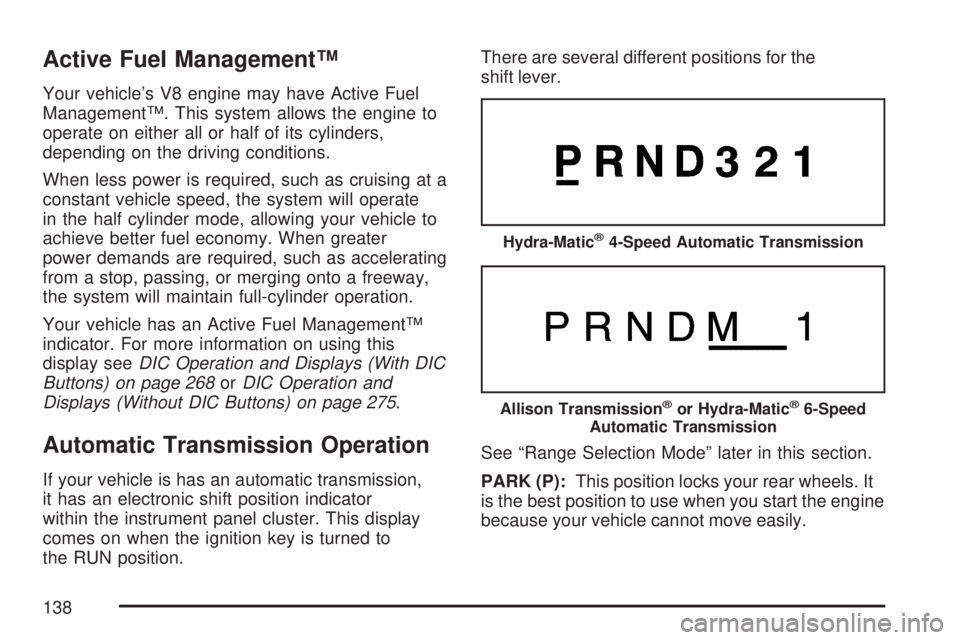
Active Fuel Management™
Your vehicle’s V8 engine may have Active Fuel
Management™. This system allows the engine to
operate on either all or half of its cylinders,
depending on the driving conditions.
When less power is required, such as cruising at a
constant vehicle speed, the system will operate
in the half cylinder mode, allowing your vehicle to
achieve better fuel economy. When greater
power demands are required, such as accelerating
from a stop, passing, or merging onto a freeway,
the system will maintain full-cylinder operation.
Your vehicle has an Active Fuel Management™
indicator. For more information on using this
display seeDIC Operation and Displays (With DIC
Buttons) on page 268orDIC Operation and
Displays (Without DIC Buttons) on page 275.
Automatic Transmission Operation
If your vehicle is has an automatic transmission,
it has an electronic shift position indicator
within the instrument panel cluster. This display
comes on when the ignition key is turned to
the RUN position.There are several different positions for the
shift lever.
See “Range Selection Mode” later in this section.
PARK (P):This position locks your rear wheels. It
is the best position to use when you start the engine
because your vehicle cannot move easily.
Hydra-Matic®4-Speed Automatic Transmission
Allison Transmission®or Hydra-Matic®6-Speed
Automatic Transmission
138
Page 139 of 680
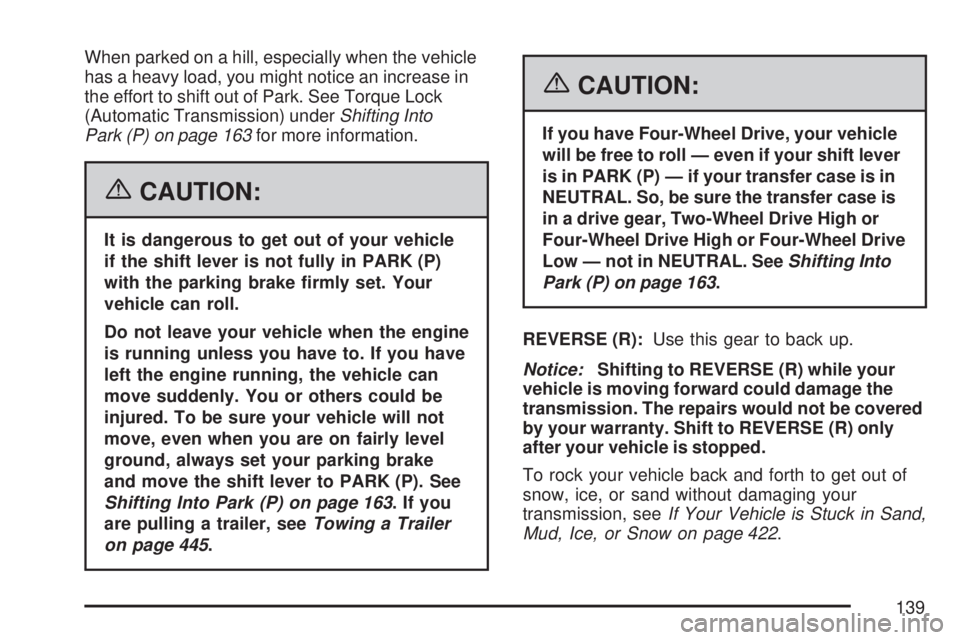
When parked on a hill, especially when the vehicle
has a heavy load, you might notice an increase in
the effort to shift out of Park. See Torque Lock
(Automatic Transmission) underShifting Into
Park (P) on page 163for more information.
{CAUTION:
It is dangerous to get out of your vehicle
if the shift lever is not fully in PARK (P)
with the parking brake �rmly set. Your
vehicle can roll.
Do not leave your vehicle when the engine
is running unless you have to. If you have
left the engine running, the vehicle can
move suddenly. You or others could be
injured. To be sure your vehicle will not
move, even when you are on fairly level
ground, always set your parking brake
and move the shift lever to PARK (P). See
Shifting Into Park (P) on page 163.Ifyou
are pulling a trailer, seeTowing a Trailer
on page 445.
{CAUTION:
If you have Four-Wheel Drive, your vehicle
will be free to roll — even if your shift lever
is in PARK (P) — if your transfer case is in
NEUTRAL. So, be sure the transfer case is
in a drive gear, Two-Wheel Drive High or
Four-Wheel Drive High or Four-Wheel Drive
Low — not in NEUTRAL. SeeShifting Into
Park (P) on page 163.
REVERSE (R):Use this gear to back up.
Notice:Shifting to REVERSE (R) while your
vehicle is moving forward could damage the
transmission. The repairs would not be covered
by your warranty. Shift to REVERSE (R) only
after your vehicle is stopped.
To rock your vehicle back and forth to get out of
snow, ice, or sand without damaging your
transmission, seeIf Your Vehicle is Stuck in Sand,
Mud, Ice, or Snow on page 422.
139
Page 140 of 680

NEUTRAL (N):In this position, your engine does
not connect with the wheels. To restart when
you are already moving, use NEUTRAL (N) only.
Also, use NEUTRAL (N) when your vehicle is
being towed.
{CAUTION:
Shifting into a drive gear while your engine
is running at high speed is dangerous.
Unless your foot is �rmly on the brake
pedal, your vehicle could move very
rapidly. You could lose control and hit
people or objects. Do not shift into a
drive gear while your engine is running
at high speed.
Notice:Shifting out of PARK (P) or
NEUTRAL (N) with the engine running at high
speed may damage the transmission. The
repairs would not be covered by your warranty.
Be sure the engine is not running at high
speed when shifting your vehicle.DRIVE (D):This position is for normal driving. It
provides the best fuel economy for your vehicle. If
you need more power for passing, and you are:
Going less than about 35 mph (55 km/h),
push your accelerator pedal about
halfway down.
Going about 35 mph (55 km/h) or more, push
the accelerator all the way down.
By doing this, the vehicle shifts down to the
next gear and has more power.
DRIVE (D) can be used when towing a trailer,
carrying a heavy load, driving on steep hills, or for
off-road driving. You might want to shift the
transmission to a lower gear selection if the
transmission shifts too often.
Downshifting the transmission in slippery road
conditions could result in skidding. See Skidding
underLoss of Control on page 389.
Your vehicle has a shift stabilization feature that
adjusts the transmission shifting to the current
driving conditions in order to reduce rapid upshifts
and downshifts.
140
Page 141 of 680
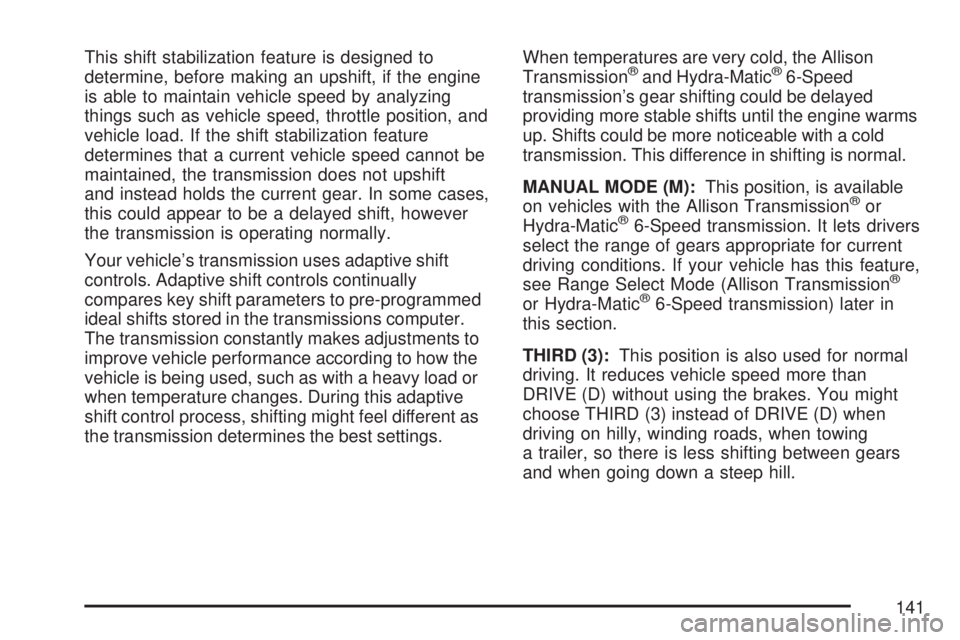
This shift stabilization feature is designed to
determine, before making an upshift, if the engine
is able to maintain vehicle speed by analyzing
things such as vehicle speed, throttle position, and
vehicle load. If the shift stabilization feature
determines that a current vehicle speed cannot be
maintained, the transmission does not upshift
and instead holds the current gear. In some cases,
this could appear to be a delayed shift, however
the transmission is operating normally.
Your vehicle’s transmission uses adaptive shift
controls. Adaptive shift controls continually
compares key shift parameters to pre-programmed
ideal shifts stored in the transmissions computer.
The transmission constantly makes adjustments to
improve vehicle performance according to how the
vehicle is being used, such as with a heavy load or
when temperature changes. During this adaptive
shift control process, shifting might feel different as
the transmission determines the best settings.When temperatures are very cold, the Allison
Transmission®and Hydra-Matic®6-Speed
transmission’s gear shifting could be delayed
providing more stable shifts until the engine warms
up. Shifts could be more noticeable with a cold
transmission. This difference in shifting is normal.
MANUAL MODE (M):This position, is available
on vehicles with the Allison Transmission
®or
Hydra-Matic®6-Speed transmission. It lets drivers
select the range of gears appropriate for current
driving conditions. If your vehicle has this feature,
see Range Select Mode (Allison Transmission
®
or Hydra-Matic®6-Speed transmission) later in
this section.
THIRD (3):This position is also used for normal
driving. It reduces vehicle speed more than
DRIVE (D) without using the brakes. You might
choose THIRD (3) instead of DRIVE (D) when
driving on hilly, winding roads, when towing
a trailer, so there is less shifting between gears
and when going down a steep hill.
141
Page 142 of 680

SECOND (2):This position reduces vehicle speed
even more than THIRD (3) without using your
brakes. You can use SECOND (2) on hills. It can
help control your speed as you go down steep
mountain roads, but then you would also want to
use the brakes off and on.
If you manually select SECOND (2) in an automatic
transmission, the transmission will start in second
gear. You can use this feature for reducing the
speed of the rear wheels when you are trying to
start your vehicle from a stop on slippery road
surfaces.
FIRST (1):For the Hydra-Matic
®4-Speed
transmission this position reduces vehicle speed
even more than SECOND (2) without using
the brakes. You can use it on very steep hills, or
in deep snow or mud. If the shift lever is put
in FIRST (1) while the vehicle is moving forward,
the transmission does not shift into �rst gear
until the vehicle is going slowly enough.For an Allison Transmission
®or Hydra-Matic®
6-Speed transmission, this position reduces
vehicle speed without using your brakes. You can
use it for major/severe downgrades and off-road
driving where the vehicle would otherwise
accelerate due to steepness of grade. When you
shift to FIRST (1) it provides the lowest gear
appropriate to your current road speed and
continues to downshift as the vehicle slows,
eventually downshifting to FIRST (1) gear.
Notice:Spinning the tires or holding the
vehicle in one place on a hill using only the
accelerator pedal may damage the
transmission. The repair will not be covered by
your warranty. If you are stuck, do not spin
the tires. When stopping on a hill, use the
brakes to hold the vehicle in place.
142
Page 143 of 680
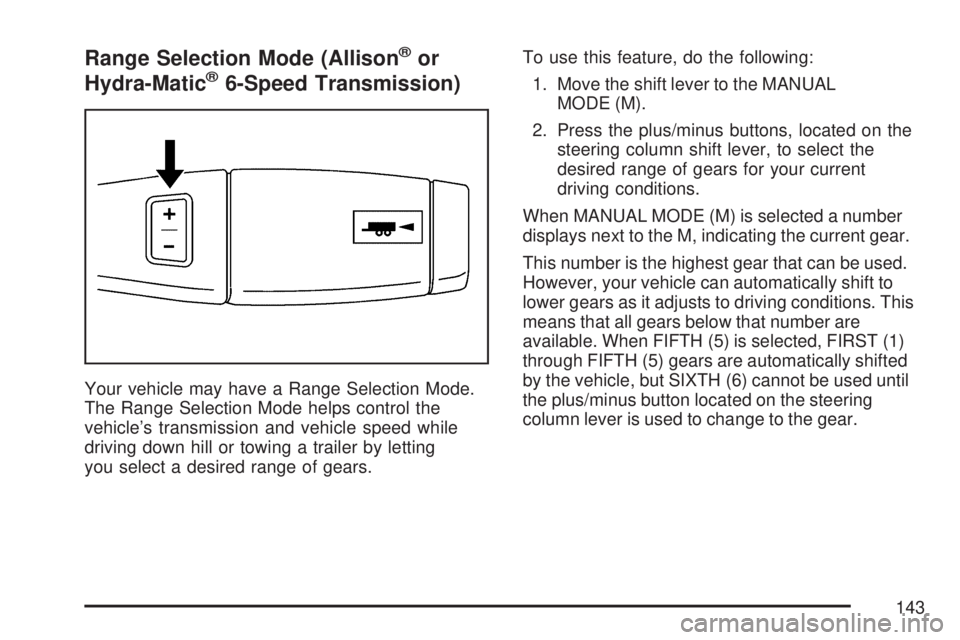
Range Selection Mode (Allison®or
Hydra-Matic®6-Speed Transmission)
Your vehicle may have a Range Selection Mode.
The Range Selection Mode helps control the
vehicle’s transmission and vehicle speed while
driving down hill or towing a trailer by letting
you select a desired range of gears.To use this feature, do the following:
1. Move the shift lever to the MANUAL
MODE (M).
2. Press the plus/minus buttons, located on the
steering column shift lever, to select the
desired range of gears for your current
driving conditions.
When MANUAL MODE (M) is selected a number
displays next to the M, indicating the current gear.
This number is the highest gear that can be used.
However, your vehicle can automatically shift to
lower gears as it adjusts to driving conditions. This
means that all gears below that number are
available. When FIFTH (5) is selected, FIRST (1)
through FIFTH (5) gears are automatically shifted
by the vehicle, but SIXTH (6) cannot be used until
the plus/minus button located on the steering
column lever is used to change to the gear.
143